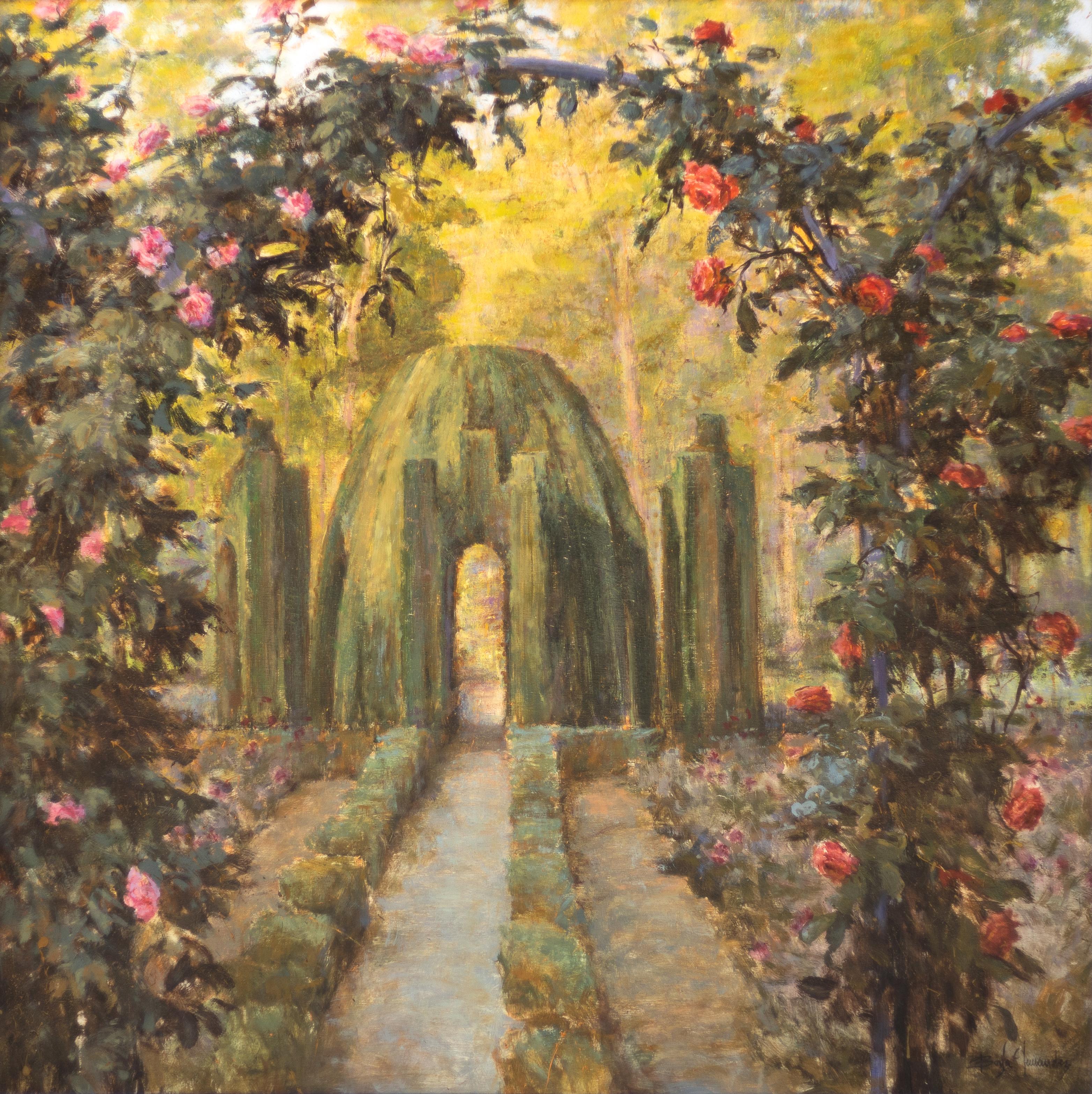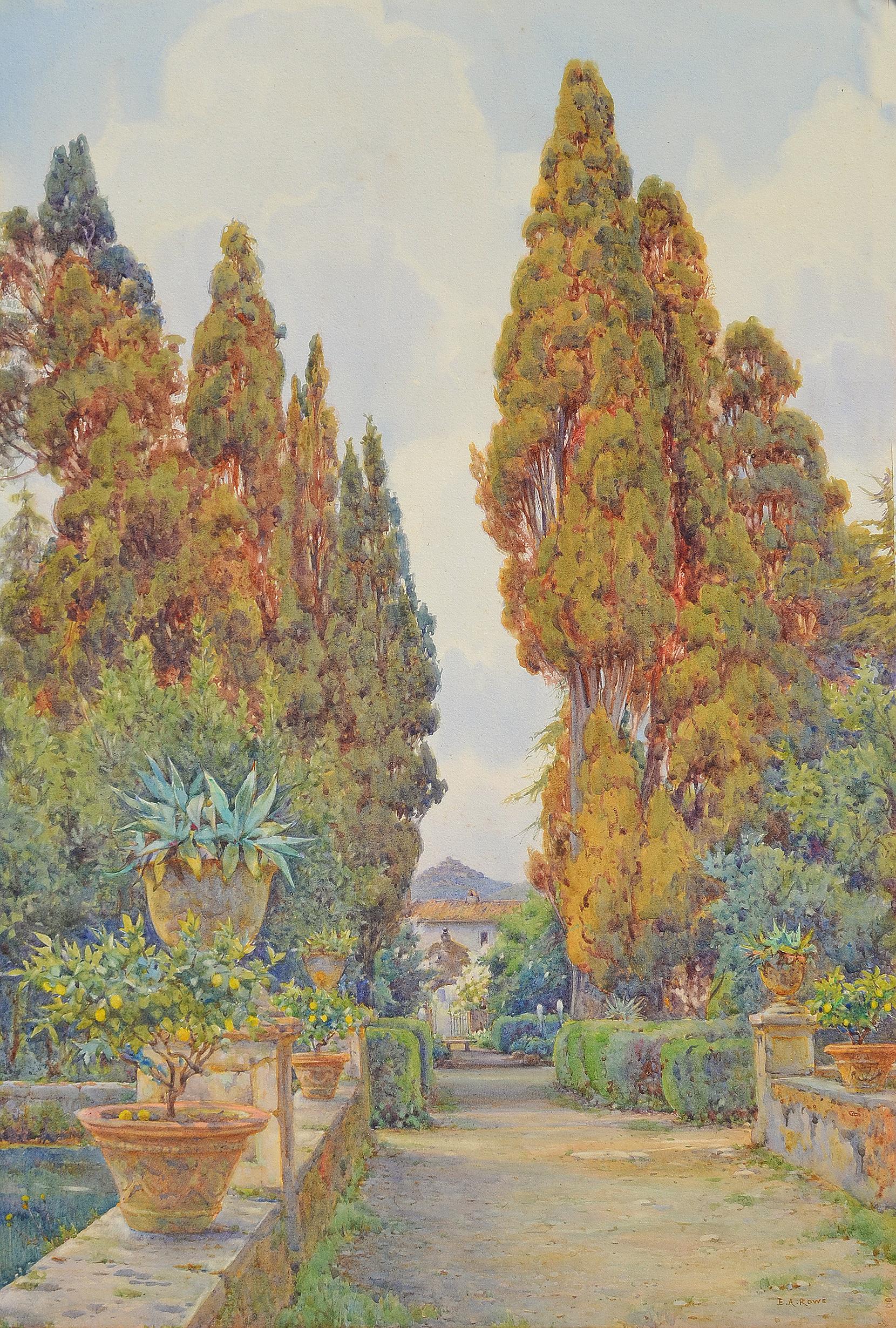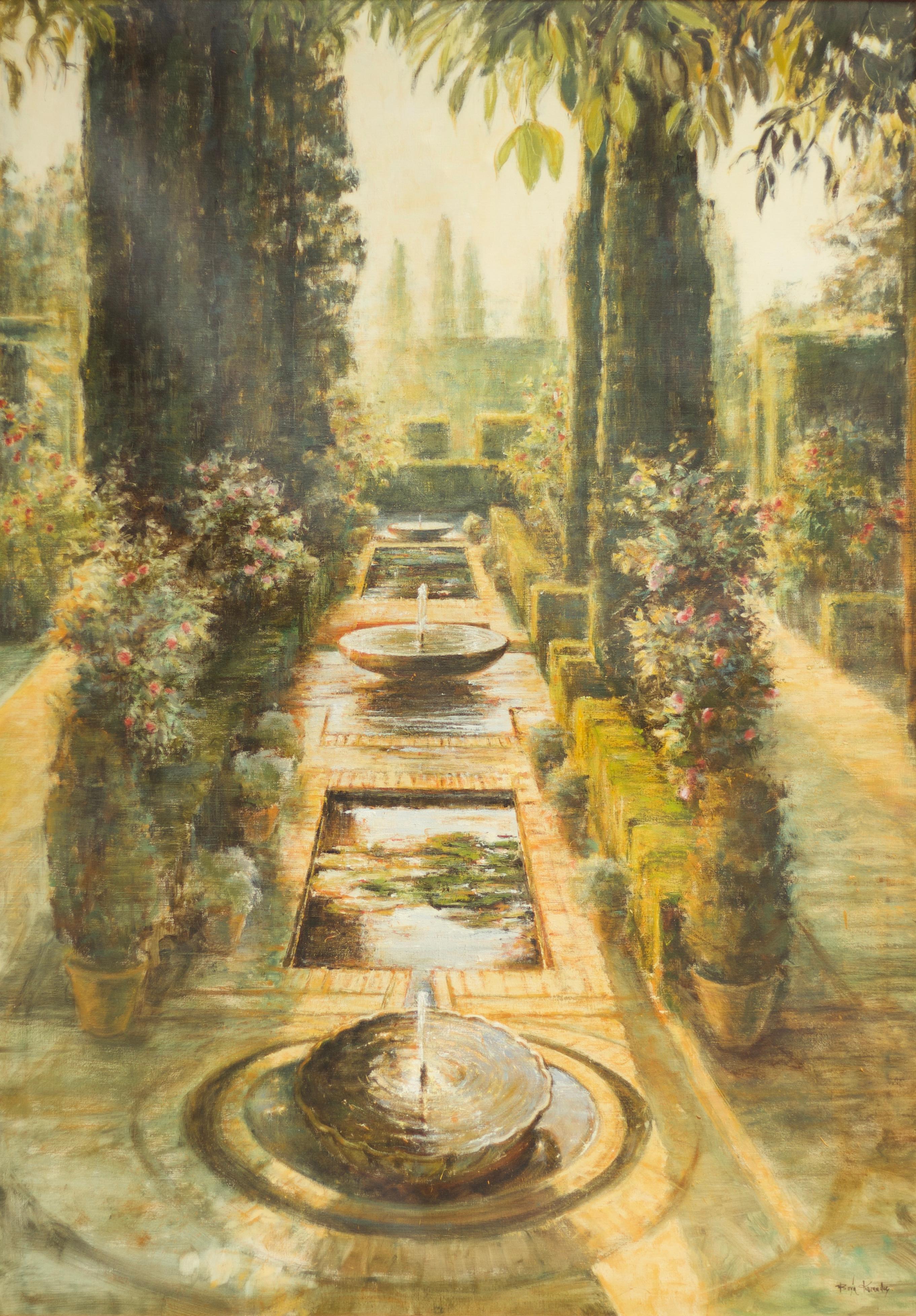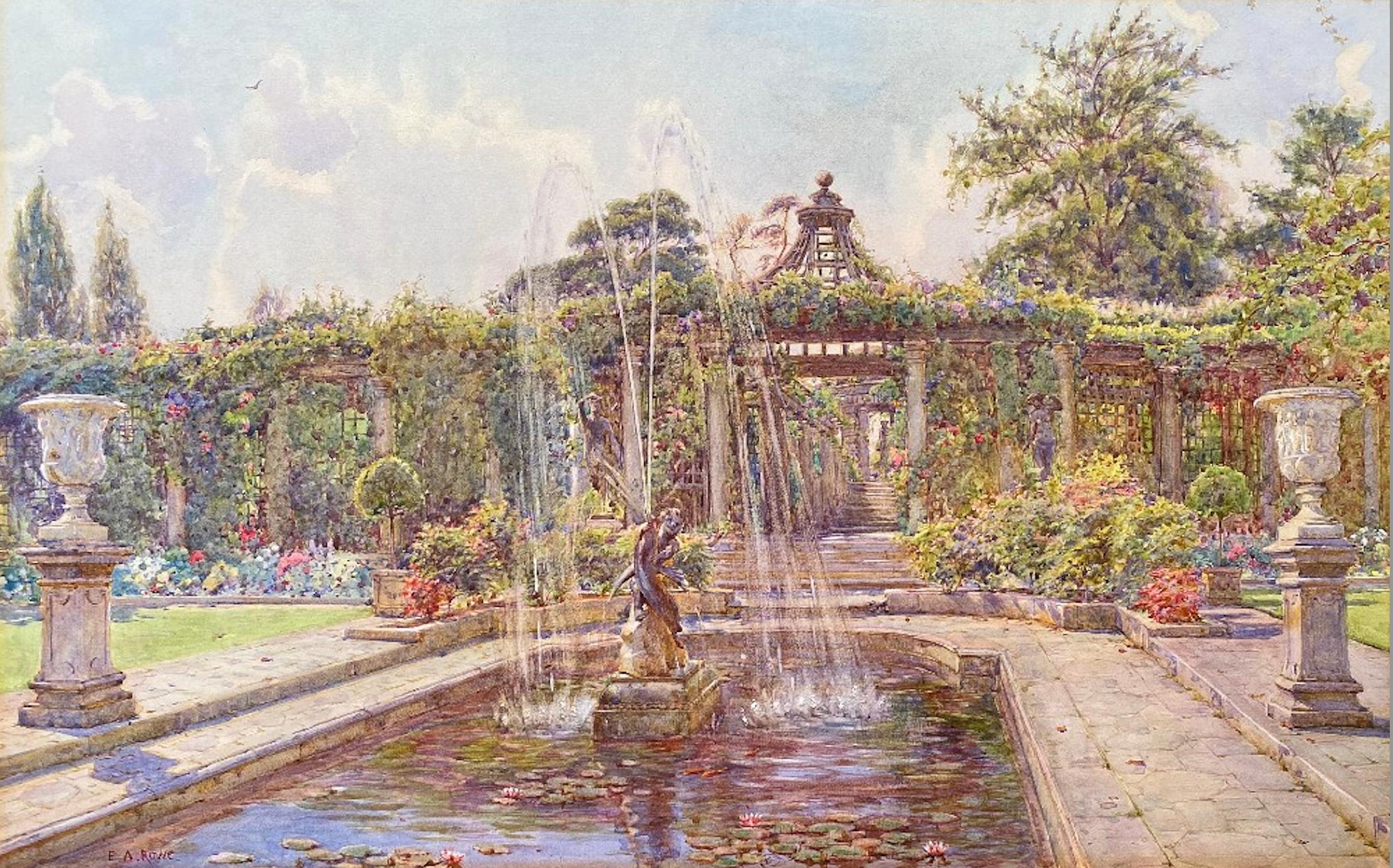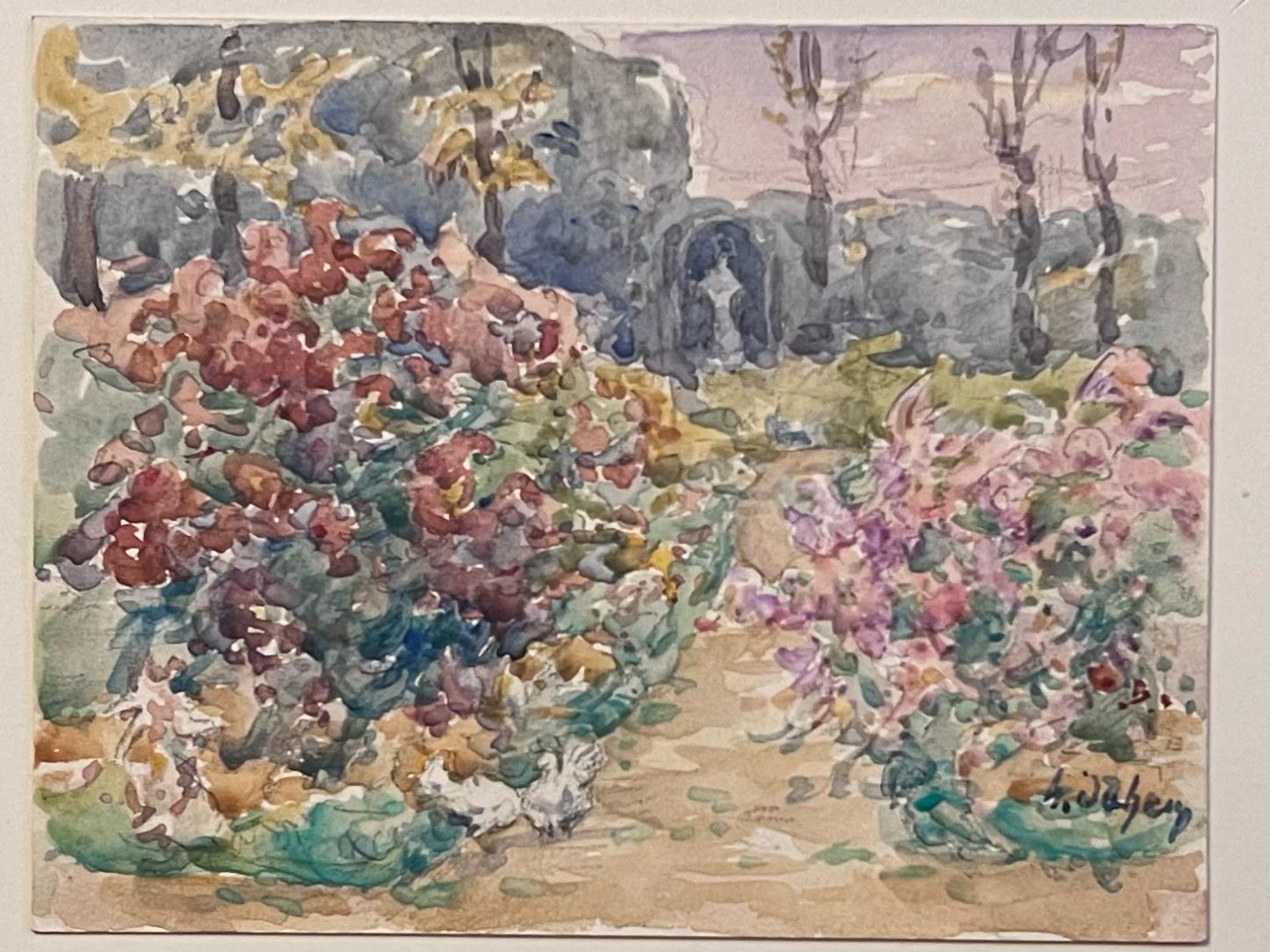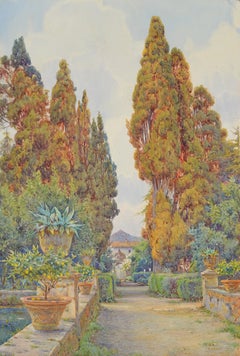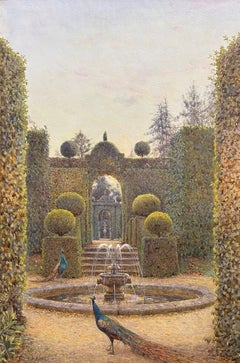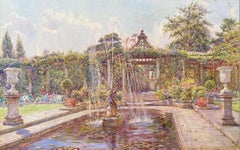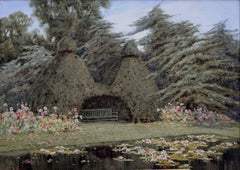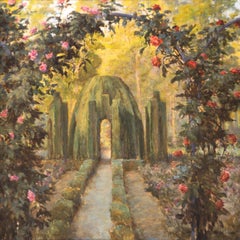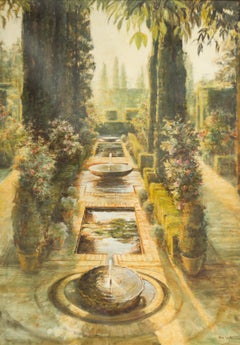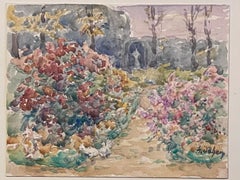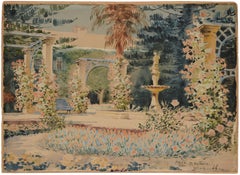Items Similar to Flower Gardens at Generalife, Granada
Want more images or videos?
Request additional images or videos from the seller
1 of 2
Ernest Arthur RoweFlower Gardens at Generalife, Granada
$8,249.99
£6,100
€7,221.97
CA$11,406.32
A$12,777
CHF 6,710.94
MX$155,364.24
NOK 84,982.46
SEK 80,671.20
DKK 53,900.37
About the Item
Watercolour on paper, signed bottom left
Image size: 13 3/4 x 9 1/2 inches (35 x 24 cm)
Mounted and framed
The Generalife was a summer palace and country estate of the Nasrid rulers of the Emirate of Granada in Al-Andalus. It is located directly east of, and uphill from, the Alhambra palace complex in Granada, Spain.
The Generalife gardens occupy three large terraces on the hillside, each measuring about 35 metres (115 ft) wide by 250 metres (820 ft) long. The two lower terraces, on the southwest side, are occupied by market gardens and orchards. Known today as Las Huertas, these gardens have served this purpose since the 14th century. The highest terrace is occupied by the Jardines Nuevos ("New Gardens"), a series of 20th-century gardens that form the main approach to the historic palaces today.
The southern part of this garden area was designed by Francisco Prieto Moreno and finished in 1951. It includes walls formed by trimmed cypress trees and a large cruciform pool inspired by Islamic/Moorish gardens, along with other decorative plants. An open-air theatre was also added here in 1952. The northern part of the gardens, which features a rose bush labyrinth, was designed by Leopoldo Torres Balbás in 1931
Ernest Arthur Rowe
Rowe was a watercolourist specialising in garden scenes. He spent his career responding to the Victorian love of formal gardens with his meticulous paintings of the grounds of the country’s finest historic houses. Ernest Arthur Rowe was born in West Ham, which was then in Essex. He trained first as a lithographer and, in 1884, began studying at the Royal Institute of Painters in Water Colours where he won a President’s Medal in 1885.
Initially, Rowe painted landscapes in general, but by the 1890s he was specialising in gardens. During that decade, he joined the London Sketch Club where he met Arthur Rackham and Beatrice Parsons, among others. Rowe’s early career was marked with little financial success. However, in 1895, he embarked on a sketching tour of the south coast and, upon meeting Mrs Hamlyn, the owner of Clovelly Court in Devon, became engaged in a series of country house commissions.
- Creator:Ernest Arthur Rowe (1860 - 1922, British)
- Dimensions:Height: 9 in (22.86 cm)Width: 13.75 in (34.93 cm)
- More Editions & Sizes:1 of 1Price: $8,250
- Medium:
- Movement & Style:
- Period:
- Condition:
- Gallery Location:London, GB
- Reference Number:1stDibs: LU52413901902
About the Seller
5.0
Vetted Professional Seller
Every seller passes strict standards for authenticity and reliability
Established in 2007
1stDibs seller since 2014
82 sales on 1stDibs
Typical response time: 1 hour
- ShippingRetrieving quote...Shipping from: London, United Kingdom
- Return Policy
Authenticity Guarantee
In the unlikely event there’s an issue with an item’s authenticity, contact us within 1 year for a full refund. DetailsMoney-Back Guarantee
If your item is not as described, is damaged in transit, or does not arrive, contact us within 7 days for a full refund. Details24-Hour Cancellation
You have a 24-hour grace period in which to reconsider your purchase, with no questions asked.Vetted Professional Sellers
Our world-class sellers must adhere to strict standards for service and quality, maintaining the integrity of our listings.Price-Match Guarantee
If you find that a seller listed the same item for a lower price elsewhere, we’ll match it.Trusted Global Delivery
Our best-in-class carrier network provides specialized shipping options worldwide, including custom delivery.More From This Seller
View AllCypresses, Villa D'Este, Tivoli, Early 20th Century English Watercolour
By Ernest Arthur Rowe
Located in London, GB
Watercolour, signed and dated '1912' bottom right
Image size: 21 x 14 inches (53.25 x 35.5 cm)
Original frame
Exhibitions
The Fine Arts Society
Ernest Arthur Rowe
Rowe was a watercolourist specialising in garden scenes. He spent his career responding to the Victorian love of formal gardens with his meticulous paintings of the grounds of the country’s finest historic houses. Ernest Arthur Rowe was born in West Ham, which was then in Essex. He trained first as a lithographer and, in 1884, began studying at the Royal Institute of Painters in Water Colours where he won a President’s Medal in 1885.
Initially, Rowe painted landscapes in general, but by the 1890s he was specialising in gardens. During that decade, he joined the London Sketch...
Category
1910s Landscape Drawings and Watercolors
Materials
Watercolor
Brockenhurst Gardens
By Ernest Arthur Rowe
Located in London, GB
Brockenhurst Gardens
Ernest Arthur Rowe
Watercolour, signed lower left and dated 1900 bottom left
Image Size: 12 x 18 3/4 inches (46 x 30.5 cm)
Original Victorian frame
Provenance
Dowdeswell and Dowdeswell
The collection of C. Buttersworth
Sale, Bonhams, London, 10th June 1998, lot 63
Exhibited
Royal Institute of Painters in Watercolour, as 'Relics of the Civil Wars, Compton Wynyates', no.1
This watercolour is one of Rowe's few pictures of Brockenhurst park garden in the New Forest, Hampshire. Here Rowe exemplifies the garden's splendour through his deliberate low positioning within the composition. As well as the scenes mirrored...
Category
20th Century Post-War Landscape Drawings and Watercolors
Materials
Paper, Watercolor
The Hill, Hampstead, Signed Early 20th Century British Watercolour
By Ernest Arthur Rowe
Located in London, GB
Watercolour and scratching out on paper, signed lower left
Image size: 11 x 17 1/2 inches (28 x 44.5 cm)
Original giltwood frame
Provenance
Christopher Wood Gallery
R Mellon, USA
...
Category
Early 20th Century Victorian Landscape Drawings and Watercolors
Materials
Watercolor
The Lily Pond, English School 19th Century Watercolour Signed
By Lillian Stannard
Located in London, GB
Lillian Stannard
1877 - 1944
The Lily Pond
Watercolour, signed lower left
Image size: 9 ½ x 13 ½ inches
Contemporary gilt frame
Lillian Stannard was a celebrated painter of En...
Category
19th Century Landscape Drawings and Watercolors
Materials
Watercolor
St Peters Rome, 19th Century Victorian Signed Watercolour
By Ernest Arthur Rowe
Located in London, GB
ERNEST ARTHUR ROWE 1863 - 1922
St Peter's Rome
Watercolour
Signed lower left
Image size: 9 ¾ x 7 inches
Original gilt frame
Category
19th Century Victorian Landscape Drawings and Watercolors
Materials
Watercolor
A River Landscape, 19th Century British Watercolour, Signed and Dated 1880
By Alfred East
Located in London, GB
Watercolour on paper, signed and dated '1880' bottom left
Image size: 9 x 13 inches (23 x 30 cm)
Hand made gilt frame
Sir Alfred East
Sir Alfred East was born in Kettering, Northa...
Category
1880s Modern Landscape Drawings and Watercolors
Materials
Watercolor
You May Also Like
"El Cenador" Spanish Garden Landscape
By Borja Fernandez
Located in Austin, TX
By Borja Fernandez
39.25" x 39.25" Oil on Board
Framed Size: 46" x 46"
Category
21st Century and Contemporary Landscape Paintings
Materials
Oil, Board
"Contra Luz - Jardines Generalife, Granada" Palace Garden Spain Roses Fountains
By Borja Fernandez
Located in Austin, TX
"Contra Luz" - Jardines Generalife, Granada
Artist: Borja Fernandez
Medium: Oil on Canvas
Size: 63.75" x 45"
Category
21st Century and Contemporary Landscape Paintings
Materials
Canvas, Oil
Fine Antique French Impressionist Painting Flower Beds in Garden
Located in Cirencester, Gloucestershire
The artist:
Henri Aime Duhem (1860-1941) French *see notes below, signed
Title: The Flower Garden
Medium:
gouache on paper, loosely laid over card, unframed
card: 9.75 x 12.75...
Category
19th Century Impressionist Landscape Paintings
Materials
Gouache
"San Anton Palace Malta" Early 20th Cent. Garden and Fountain Watercolor Russian
Located in Soquel, CA
A significant early 20th century landscape watercolor of the paradisical gardens at San Anton Palace in Attard, Malta by Nicholas Krasnoff, 1920 (Russian, 1864-1939). This beautiful piece is a wonderful example of the renowned Russian architect's prized watercolors, created while he was exiled to Malta in the early 1920's. Depicting a lush garden full of blooming, colorful flowers and a stately fountain at the San Anton Palace in Malta, one can see the deft hand and attention to detail rendered by the proficient artist and architect's hand.
Signed "N. Krasnoff" lower right. Titled and dated "Malta, St. Antonio 1920".
Unframed.
Measures 10.25"H x 14.25"W.
Right corner has a crease from being bent.
Nikolay Petrovich Krasnov, also known as Nicholas Krasnoff or Peter Nicholas Krasnoff, was a Russian Serbian architect and painter. He served as Chief Architect of Yalta, Crimea (1887-1899). From 1922 he lived and worked in the Kingdom of Yugoslavia, and was a key figure in the architectural development of Belgrade. Attending the Moscow School of Painting, Sculpture and Architecture in 1876, aged 12. As a young artist he received patronage from Sergey Tretyakov, brother of the founder of Moscow's Tretyakov Gallery, and entrepreneur Petar Gubonyin.
In 1887 Krasnov became Chief Architect in Yalta. At the age of 23, Krasnov had large responsibility for the rapid growth of the city. He expanded the promenade, which by 1913 became the city's main street, before creating a new city plan in 1889 (including a new sewer system, planning regulations, new streets, prevention of unregulated construction, a school and children's hospital, and the construction of the Pushkin Boulevard). Two concrete bridges were built over the river, and the embankment strengthened. Krasnov also ran a private practice in Yalta until 1911. Among his most famous work is the Livadia Palace, later the location of the 1945 Yalta Conference. Designed over 60 buildings in Crimea, blending a modernist style with local traditions. Also of note: Dulber Palace, Koreiz (1895-97), Alexander Nevsky Cathedral, Yalta (1902), Yusupov Palace, Koreiz (1909), Kokkoz Jami Mosque, Sokolyne (1910).
In 1913, he presented a collection of illustrations he had produced of his works to the Saint Petersburg Academy of Arts, where he held the title of academician. An opponent of the Russian Revolution, he left Yalta with his family in 1919 for Malta, alongside the Dowager Empress Marie Feodorovna, sister of Queen Alexandra, and over 600 members of the Russian aristocracy. Nikolay was in a group housed in the empty Villa St Ignatius, which had been a Jesuit college and then a hospital during World War I. To earn money, Nikolay painted many scenes of Malta, signing his paintings as N. Krasnoff. He is known as Nicholas Krasnoff in Malta. In May 2016 MaltaPost issued a commemorative set of stamps in his honor.
In 1922 Krasnov moved to Belgrade, then part of the Kingdom of Yugoslavia, where he became head of the Department of Monumental Architectural Developments and Monuments. His building designs in Serbia number around 60, and were created under the name Nikola Krasnov, as a mark of respect to his adopted homeland.
His key works in Belgrade include: Ministry of Forestry building (now Ministry of Foreign Affairs) (1923) which bears a memorial plaque...
Category
1920s Impressionist Landscape Drawings and Watercolors
Materials
Paper, Watercolor, Illustration Board
Finely Detailed British Watercolor Topographical of a Mogul Garden in Pakistan
Located in Cirencester, Gloucestershire
Medium: Watercolour on paper, unframed
Size: 10 inches (height) x 14 inches (width)
Signed: Yes
Condition: Sound condition, with some minor signs of foxing visible
Provenance: Privat...
Category
Mid-20th Century Impressionist Landscape Paintings
Materials
Watercolor
Floral Gardens - Early 20th Century Watercolor Landscape by Annie L Pressland
Located in Watford, Hertfordshire
Annie L Pressland (1892 - 1933)
A watercolor painter of flowers, gardens and still lives, she was born on 2 July 1862, the daughter of Caleb Pressla...
Category
Early 19th Century Impressionist Landscape Drawings and Watercolors
Materials
Watercolor
More Ways To Browse
Garden Drawings
Antique Paper Flowers
Landscape Drawings Flowers
Victorian House Drawing
Antique Rose Drawing
Granada Painting
Southwest Lithographs
Alhambra Painting
Alhambra Antique
Antique Orchard Painting
Granada Islamic Spain
Beatrice Parsons
Dixie Selden
Edith Hume
Edward Boit
Edward Darley Boit
Emil Barbarini
Frank Charles Peyraud
